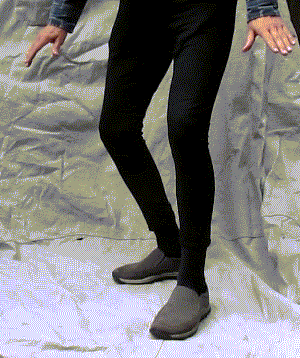
Safe Falling Class: Single-Leg Balance - a key Exercise
The single-leg balance exercise with the other foot
floating in front or behind is very important for improving your
leg strength and balance so that you can walk carefully and mindfully
in the "Tai Chi Walking" style.
An important safety note:
this exercise is for people who can walk normally, can balance
fairly easily on two feet, and can support their full body weight on a
single leg with the knee slightly bent. If you have a
weak or "trick knee," or need to use a cane or walker, you should not
do this exercise without additional safety support that is about
waist-high: a kitchen counter, a solid table, chair back, or railing.
Losing your balance slightly is an integral
part of this exercise. When you start to lose your balance, immediately put
the raised, "floating" foot down on the floor while
bending both knees. This "sinking and rooting" response,
bending both knees with both feet firmly on the floor, should become a
new trained response to a loss of balance. Never fight to
keep your balance by waving the floating foot wildly or raising it
farther from the floor. This is easier said than done because our
natural instinct is to raise the leg in the opposite direction of the
body tilt to counter-balance.
Remember to keep breathing. Everyone tends to hold their
breath when stressed... be sure to relax and keep breathing at all
times.
HOW TO DO THE "FRONT FOOT FLOAT":

Stand with one foot a few inches ahead of the rear foot. Shift
all your weight to your rear leg and make sure that the leg is slightly
bent. Slowly lift your "empty" front foot just a half-inch or so
off of the floor, and let it "float" there.
Your rear leg will not be happy -- it should be trembling and moving around trying to keep you balanced.
Breathing normally, try to hold your front foot off of the floor for several seconds.
The front leg should be relaxed, not stiff. The lower leg should just hang from the knee.
When you lose your balance, put your front foot down immediately, and bend both knees a bit.
You can hold your hands out at your sides as shown to help with your
balance. You should look down to a spot six to eight feet away on the floor: do not just look straight down at your
feet.
If you are worried about falling, you can place one or both hands lightly on a
chair back, table, or other solid object, but do not rest your weight
on your hands. Remember, you should be able to feel your rear leg
really working, especially around the ankle and knee. Your hips should
not be moving much at all.
It is important to have the floating foot slightly out in front, as if
you were going to take a step. Don't just lift the floating foot
up next to your other leg.
At first, several seconds of "floating" the front
foot at a
time is fine. When you have to touch down, re-balance on the rear
leg and start again. Repeat until you have a total foot
floating time of at least 30 seconds. Then do the exercise
again with the other foot in front. Do this routine once in the
morning, and once in the afternoon: that's only two minutes of
exercise a day, but you will feel the results. Many find they
can practice this move during their normal day when they are just
standing around. I do not advocate "multi-tasking"
with this exercise ( i.e., "Balance on one foot while brushing your
teeth.") You want to be relaxed, but mindful, focused on your
balance. Eventually, you should be able to easily float either
foot for 15 to 30 seconds at a time.
Most people who do not regularly balance on one leg as part of an
activity (such as yoga or Tai Chi) find this simple one-leg balance
exercise suprisingly difficult. After all, if you can walk you
are always putting all your weight on one leg, then the other.
But we don't notice that we are rarely balanced: normal walking
is just a series of controlled falls. Also, many people move
around with their legs almost straight, and find it hard to
support the weight of their body on a single leg if it is noticeably
bent at the knee. If you cannot support the weight of your
body on one leg with the knee even slightly bent, you should strengthen
your major leg muscles (quadriceps) with other exercises before doing the "Front Foot Float."

